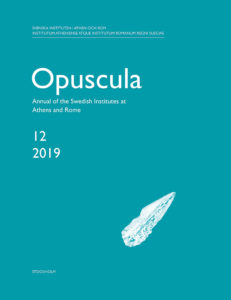 Opuscula is published by the Swedish Institutes at Athens and Rome, with the aid of a grant from the Swedish Research Council. Distributed by Eddy.se AB. View journal at ERIH PLUS. All content available with open access.
Opuscula is published by the Swedish Institutes at Athens and Rome, with the aid of a grant from the Swedish Research Council. Distributed by Eddy.se AB. View journal at ERIH PLUS. All content available with open access.
Trees and shrubs in the sanctuary. Wood charcoal analysis at the Sanctuary of Poseidon at Kalaureia, Poros
By Maria Ntinou (Aristotle University of Thessaloniki, Greece)
Abstract
Wood charcoal analysis at the Sanctuary of Poseidon at Kalaureia, Poros aims to provide information on the vegetation of the area and its management and on the range of plants used in the activities taking place at the sanctuary. During the excavations of 2003–2005 in Areas D and C, systematic samples from fills and features from all the excavated strata were recovered and water flotation was used for the separation of wood charcoal from the sediment. Wood charcoal was found in two pits dated to the Early Iron Age, near the supposed altar of the Archaic period (Feature 05), in a deposit of the Hellenistic period (the “dining deposit”), in floor deposits (Early Iron Age and Late Classical/Early Hellenistic periods), and fills of different chrono-cultural periods (Archaic–Early Roman). All the taxa identified in the wood charcoal assemblages are thermophilous Mediterranean elements, most of them evergreen broad-leaved. The assemblages show that the most frequent taxon is the olive, followed by the prickly oak, the Fabaceae, and the heather. In most assemblages mock privet/buckthorn, strawberry tree, the pear and Prunus family species are present, while Aleppo pine, lentisc, the fig, and the carob trees are less frequent. Olive cultivation was an important economic activity during the whole life of the sanctuary and probably olive pruning constantly provided the sanctuary with fuel. The woodland would be the additional source of firewood for the sanctuary’s needs for fuel for mundane activities such as heating and cooking, for more formal ones, such as sacrifice, but also for industrial activities such as tile firing. Activities related to the reorganization of space and the expansion of the sanctuary may be reflected in charcoal of carpentry by-products as the fir, cypress, and maybe pine remains.
Download PDF - Size: 685.62 KB - Downloads: 315 (since 2023)
Bibliographical information
Maria Ntinou, ’Trees and shrubs in the sanctuary. Wood charcoal analysis at the Sanctuary of Poseidon at Kalaureia, Poros’, Opuscula. Annual of the Swedish Institutes at Athens and Rome (OpAthRom) 12, Stockholm 2019, 255–269. ISSN: 2000-0898. ISBN: 978-91-977799-1-3. https://doi.org/10.30549/opathrom-12-08
Bioarchaeological remains from the Sanctuary of Poseidon at Kalaureia
The section on the bioarchaeological remains from the Sanctuary of Poseidon at Kalaureia, published in the OpAthRom 12, includes seven articles:
Arto Penttinen & Dimitra Mylona | Physical environment and daily life in the Sanctuary of Poseidon at Kalaureia, Poros. The bioarchaeological remains. Introduction
Dimitra Mylona | Animals in the sanctuary. Mammal and fish bones from Areas D and C at the Sanctuary of Poseidon at Kalaureia. With an appendix by Adam Boethius
Dale Serjeantson | Animals in the sanctuary. Bird bones and eggshell
Petros Lymberakis & Giorgos Iliopoulos | Snakes and other microfaunal remains from the Sanctuary of Poseidon at Kalaureia
George E. Syrides | Marine and terrestrial molluscs in the sanctuary. The molluscan remains from the 2003–2004 excavations in the Sanctuary of Poseidon at Kalaureia
Maria Ntinou | Trees and shrubs in the sanctuary. Wood charcoal analysis at the Sanctuary of Poseidon at Kalaureia, Poros
Anaya Sarpaki | Plants in the sanctuary. Charred seeds from Areas C and D at the Sanctuary of Poseidon at Kalaureia, Poros

No Comments
Comments are closed.